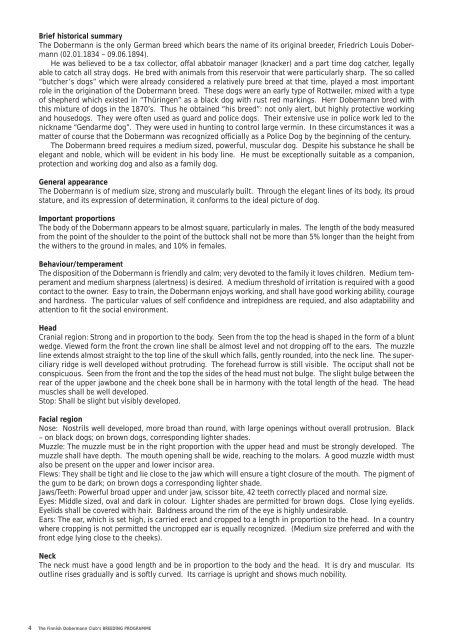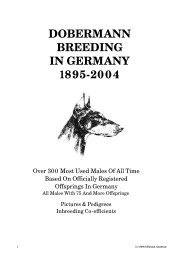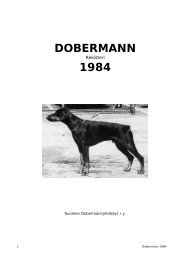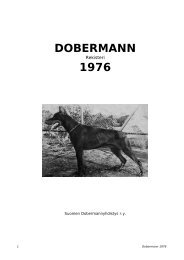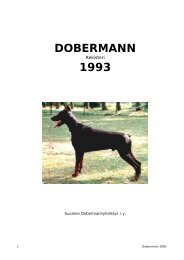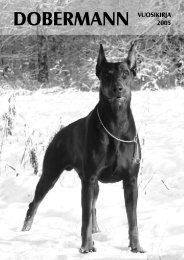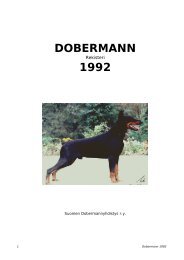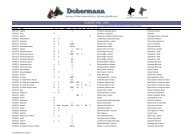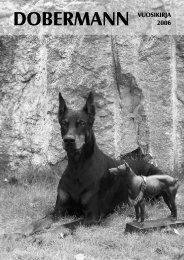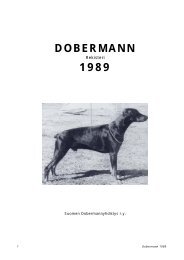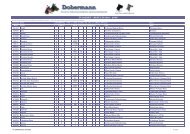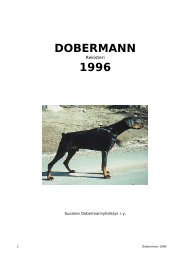Breeding Programme
Breeding Programme
Breeding Programme
You also want an ePaper? Increase the reach of your titles
YUMPU automatically turns print PDFs into web optimized ePapers that Google loves.
Brief historical summary<br />
The Dobermann is the only German breed which bears the name of its original breeder, Friedrich Louis Dobermann<br />
(02.01.1834 – 09.06.1894).<br />
He was believed to be a tax collector, offal abbatoir manager (knacker) and a part time dog catcher, legally<br />
able to catch all stray dogs. He bred with animals from this reservoir that were particularly sharp. The so called<br />
“butcher’s dogs” which were already considered a relatively pure breed at that time, played a most important<br />
role in the origination of the Dobermann breed. These dogs were an early type of Rottweiler, mixed with a type<br />
of shepherd which existed in “Thüringen” as a black dog with rust red markings. Herr Dobermann bred with<br />
this mixture of dogs in the 1870’s. Thus he obtained “his breed”: not only alert, but highly protective working<br />
and housedogs. They were often used as guard and police dogs. Their extensive use in police work led to the<br />
nickname “Gendarme dog”. They were used in hunting to control large vermin. In these circumstances it was a<br />
matter of course that the Dobermann was recognized officially as a Police Dog by the beginning of the century.<br />
The Dobermann breed requires a medium sized, powerful, muscular dog. Despite his substance he shall be<br />
elegant and noble, which will be evident in his body line. He must be exceptionally suitable as a companion,<br />
protection and working dog and also as a family dog.<br />
General appearance<br />
The Dobermann is of medium size, strong and muscularly built. Through the elegant lines of its body, its proud<br />
stature, and its expression of determination, it conforms to the ideal picture of dog.<br />
Important proportions<br />
The body of the Dobermann appears to be almost square, particularly in males. The length of the body measured<br />
from the point of the shoulder to the point of the buttock shall not be more than 5% longer than the height from<br />
the withers to the ground in males, and 10% in females.<br />
Behaviour/temperament<br />
The disposition of the Dobermann is friendly and calm; very devoted to the family it loves children. Medium temperament<br />
and medium sharpness (alertness) is desired. A medium threshold of irritation is required with a good<br />
contact to the owner. Easy to train, the Dobermann enjoys working, and shall have good working ability, courage<br />
and hardness. The particular values of self confidence and intrepidness are requied, and also adaptability and<br />
attention to fit the social environment.<br />
Head<br />
Cranial region: Strong and in proportion to the body. Seen from the top the head is shaped in the form of a blunt<br />
wedge. Viewed form the front the crown line shall be almost level and not dropping off to the ears. The muzzle<br />
line extends almost straight to the top line of the skull which falls, gently rounded, into the neck line. The superciliary<br />
ridge is well developed without protruding. The forehead furrow is still visible. The occiput shall not be<br />
conspicuous. Seen from the front and the top the sides of the head must not bulge. The slight bulge between the<br />
rear of the upper jawbone and the cheek bone shall be in harmony with the total length of the head. The head<br />
muscles shall be well developed.<br />
Stop: Shall be slight but visibly developed.<br />
Facial region<br />
Nose: Nostrils well developed, more broad than round, with large openings without overall protrusion. Black<br />
– on black dogs; on brown dogs, corresponding lighter shades.<br />
Muzzle: The muzzle must be in the right proportion with the upper head and must be strongly developed. The<br />
muzzle shall have depth. The mouth opening shall be wide, reaching to the molars. A good muzzle width must<br />
also be present on the upper and lower incisor area.<br />
Flews: They shall be tight and lie close to the jaw which will ensure a tight closure of the mouth. The pigment of<br />
the gum to be dark; on brown dogs a corresponding lighter shade.<br />
Jaws/Teeth: Powerful broad upper and under jaw, scissor bite, 42 teeth correctly placed and normal size.<br />
Eyes: Middle sized, oval and dark in colour. Lighter shades are permitted for brown dogs. Close lying eyelids.<br />
Eyelids shall be covered with hair. Baldness around the rim of the eye is highly undesirable.<br />
Ears: The ear, which is set high, is carried erect and cropped to a length in proportion to the head. In a country<br />
where cropping is not permitted the uncropped ear is equally recognized. (Medium size preferred and with the<br />
front edge lying close to the cheeks).<br />
Neck<br />
The neck must have a good length and be in proportion to the body and the head. It is dry and muscular. Its<br />
outline rises gradually and is softly curved. Its carriage is upright and shows much nobility.<br />
4 The Finnish Dobermann Club’s BREEDING PROGRAMME


